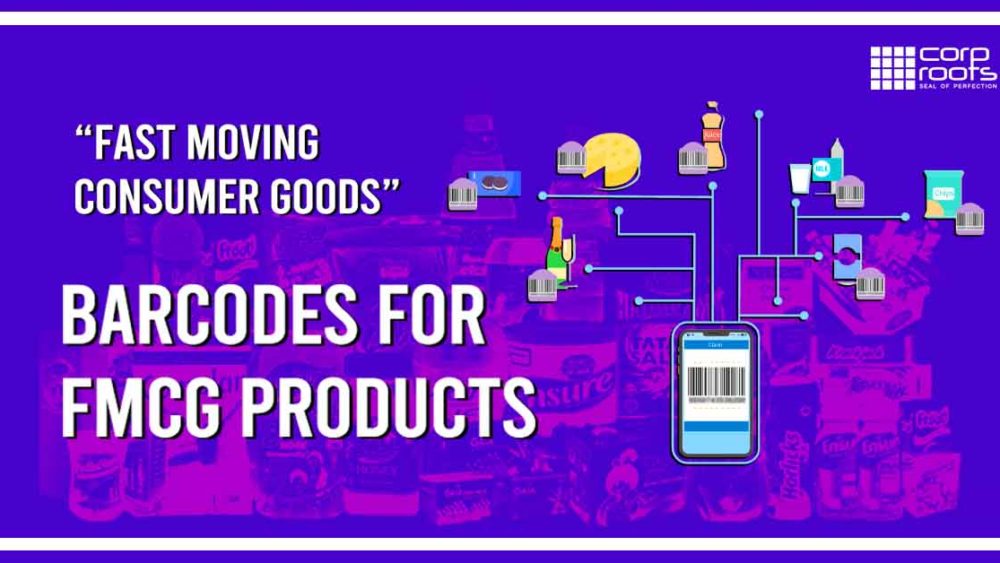BARCODES FOR FMCG AND PRODUCTS are everywhere . They can be seen on the smallest products from your nearby grocery stores to even something big being exported outside the country. It prevents shoplifting( because each product have to be scanned at the counter), helps to easily organise,manage and track products on the go. Therefore, Barcodes provide a unique solution to many problems. So now the question is How does it really work? If we explain it in Layman terms, a barcode is simply a string of data which is visually represented and can be read by a machine. These Barcodes are scanned or read by a special optical scanner called Barcode scanner. There's two types of Barcodes: 1-Dimensional and 2-Dimensional>> The most common type of Barcodes we see around is the 1D barcode. 2D barcodes are made of rectangles, hexagons and other 2D shapes. Even though 2D barcodes doesn't contain bars, they are still called barcodes. These doesn't require special scanners and can be even read and deconstructed by mobile devices with in-built cameras. WHAT IS FMCG? FMCG refers to Fast moving Consumer goods. These include products that sell quickly and which are sold at a low cost.FMCG and products have high demand and low shelf-life as the products are sold out quickly(like eatables-bakery items,meat,diary items etc). They are also called consumer packaged goods. Fast moving consumer goods takes up a large portion of the total consumer goods. These are non-durable(having less life and consumed immediately) and we buy them on a day-to-day basis. For eg:- When we go to a grocery store to buy milk, fruits & vegetables or even a bubblegum, all these fall into the FMCG category. FUN FACT: The very first time a barcode was used and scanned in history was on a pack of Wrigley's chewing gum(a packaged consumer good!).It was in 1974 at a supermarket in Ohio. WHY ARE BARCODES NECESSARY FOR FMCG? 1.As these products have high demand and low shelf life. Using Barcodes increases the overall efficiency and speed in the supply chain process. Eg:When the products reach the grocery store(Restocking) and when people buy this(scanning at the bill counter) 2.Also it has become impossible for modern retailing to function without a barcode. Barcode helps to scan products on-the-go and to calculate the prices easily. Barcodes play a major role in the billing process and in tracking a product through a supply chain. 3.There are certain laws that have made barcodes compulsory. Most retailers won't accept your product if there is no barcode. Also the onus of putting barcodes lies on the manufacturers and not on the retailers. 4.The most recommended type of barcodes are the GS1 barcodes which has become the de-facto standard in the retail-world. Over 5 billion GS1 barcodes are scanned everyday at retail shops all over the world. 5.Consider you are a manufacturer selling a particular product. Barcode helps to encompass the entire supply chain process. Starting from your manufacturing plant, through the distribution network and even till the end line of a retail (when someone buys your product) or on online-shopping sites. So WHAT DOES A FMGC BARCODE CONTAIN? When you are in a supermarket and you are at the billing desk,you may have noticed the check-out clerk scanning your product with a special scanner. There is centralised Database on the computer which keeps track of the stock levels, prices etc of all products in that shop or store. After the scan, the price of the product comes up on the software.For eg:- if you wanted to buy 50 packs of ice-creamand the shop has exactly 50 packs,while at the check-out,the system will understand that the stock has run out and will notify for a restock. A barcode necessarily contains information about that product. How to apply for a GS1 Barcode for your product? a)The very first step is to approach your local GS1 office and get a unique company identification number( also called Global company prefix ). b)This unique number helps in generating different types of identification numbers that are used in different parts of a supply chain by manufacturers, retailers etc. c)This aids in automation and improves efficiency for example:- when you are taking a large stock or in checkouts, scanning barcodes reduces time.
Nov 23

